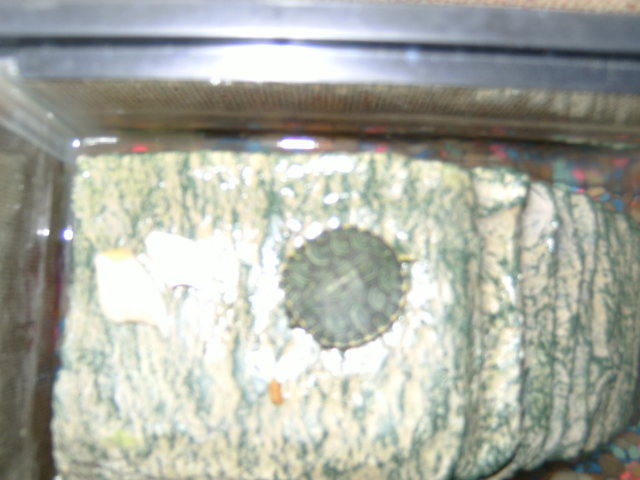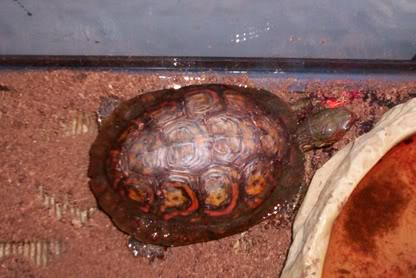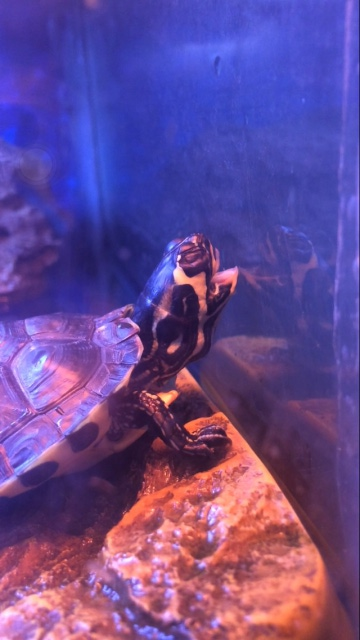Question Hello, One of my poor floating turtles died! Just before he died I noticed he had a soft shell. Once he died, the underside of his belly "cracked" and his innards "disintegrated". My other floating turtle is just beginning to get soft by his tail. What can I do to keep him from dying too? I got both these turtles at a shop down in Hilton Head, SC about a year ago. They are no bigger than a square inch and aren't supposed to get any larger. I keep them in a plastic container with slits in the top to allow air through. Unfortunately, I fear they do not get enough light. They live in a room-temperature climate and I feed them little pellets that the store gave me once a week. They share the plastic container with only water and a large rock in the corner for them to rest on. Please help!
AnswerI hate to say it, but the cares the poor turtles got were absolutely not good for them.
For example...
- Turtles are not supposed to float. Floating is usually a sign of pneumonia.
- There is NO turtle that stays smaller than 4" long as an adult, and most common pet turtles are 6-12" long as adults.
- Turtles need lots of space. The smallest recommended habitat is 10 gallons of water per inch of shell length.
- They need daily feedings that combine good pellets and live or frozen/thawed food.
- They need good light, warmth, and water filtration
If the turtle is floating and soft, you can save its life, but it is going to mean a lot of changes. You should read up on its care- I would recommend starting at http://www.redearslider.com
Turtles want three things...
- Good water. Figure 10 gallons of actual water per inch of shell length, warmed to about 75-80F for most species, and kept sparkling clean with a big filter (figure 2-3 times the size of the aquarium)
- Good sun. They need a safe, easy to access basking site. Rocks and dirt are not good, wood and plastic is OK. The basking site should be well-lit and heated to about 90F. The entire tank should be well-lit for about 12-14 hours a day- but allow a lot of shade.
- Good food. Go with about 1/2 pellets, and 1/2 live or frozen/thawed 'fish foods' like small fish, snails, shrimp, krill, worms, insects, coked chicken, beef heart, etc. A daily portion would be about the size of the turtle's head.
In addition to all of this, you are going to need to treat the illnesses the turtle has picked up. Use the fish medicine Stress Coat in the water per directions and boost water temps about 5 degrees to help with the pneumonia and other infections.
Get some turtle Cuttle Bone and see if the turtle will eat it to help it get some more calcium. Otherwise, a good diet should help with this. Natural sunlight, that does not pass through glass or plastic, will help as well. You can try a UVB light bulb if sunlight is not available or it is not eating.
I know this is a lot. The sad reality is that turtles are not simple, cheap pets even though they are often sold that way. Please understand, I get LOTS of letters from people in your situation- a turtle that is not doing well because of bad or old advice they are following.
Good luck!

 flakey substance on turtles neck and legs
Question
Red ear slider
red ear slider about 9 mos. 20
flakey substance on turtles neck and legs
Question
Red ear slider
red ear slider about 9 mos. 20
 Baby Yellow Belly Turtle
Question
My baby
I have a baby yellow belly turle no bi
Baby Yellow Belly Turtle
Question
My baby
I have a baby yellow belly turle no bi
 land/box turtle
QuestionQUESTION: My turtle has been getting an algae-l
land/box turtle
QuestionQUESTION: My turtle has been getting an algae-l
 sick spur thigh
Question
Right Left
African Spur Thigh, T
sick spur thigh
Question
Right Left
African Spur Thigh, T
 Red eared slider eyes and breathing
QuestionQUESTION: I have two sick red eared slider turt
Red eared slider eyes and breathing
QuestionQUESTION: I have two sick red eared slider turt